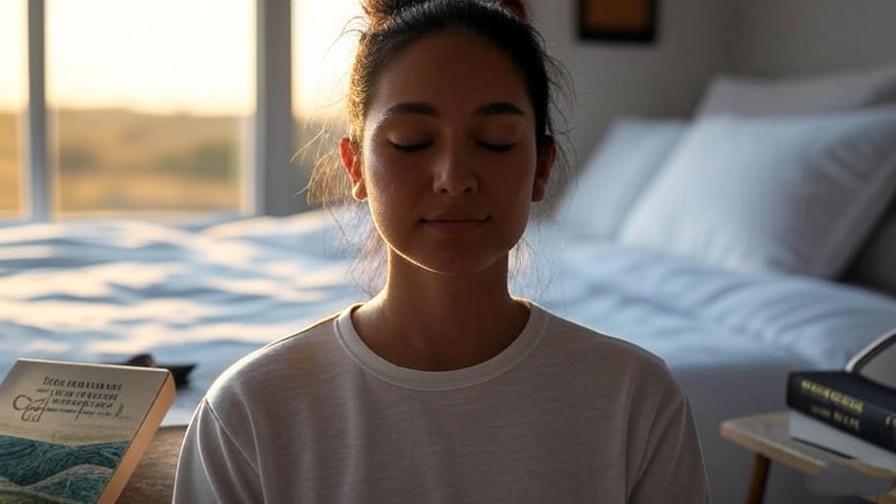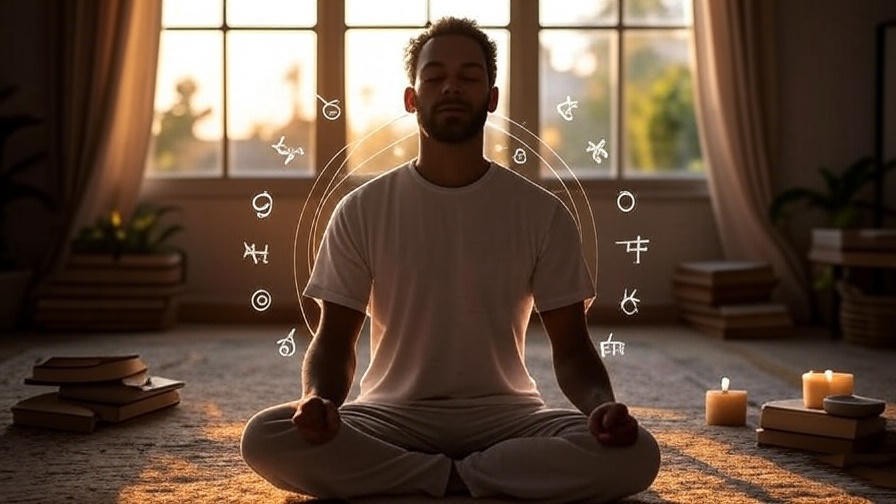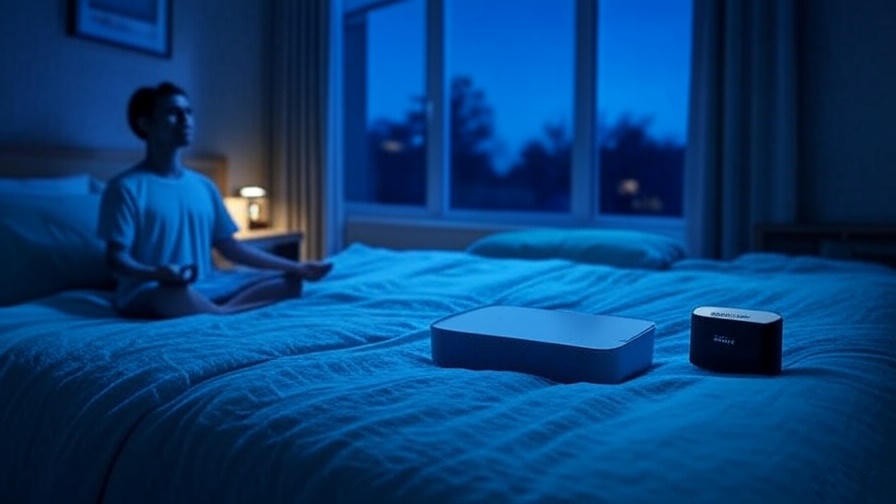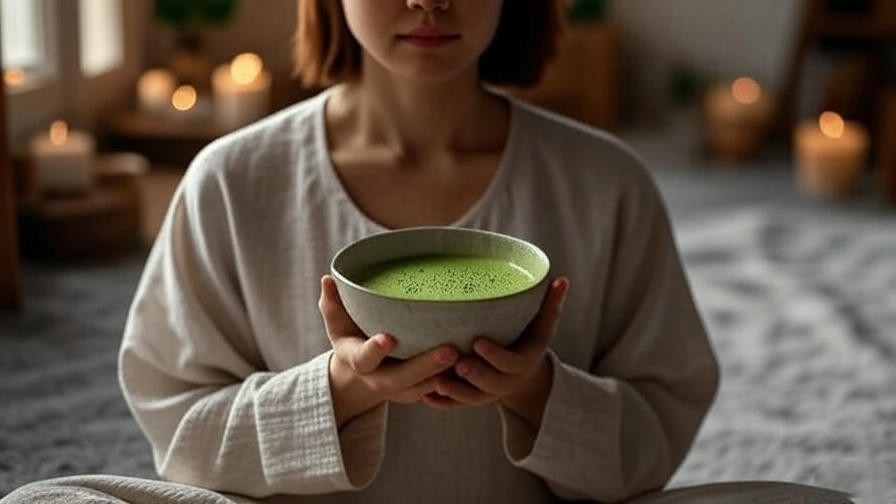Picture this: It’s the end of a long, chaotic day, and your mind feels like a tangled knot of stress and distraction. You sit down to meditate, craving calm, but silence feels heavy, and your thoughts race. Then, you press play on a soothing meditation song, and suddenly, the world softens—your breath slows, and peace begins to unfold. This is the power of music in meditation, and finding the right tracks starts with the perfect prompt for meditation songs. Whether you’re seeking stress relief, better sleep, or spiritual connection, the right music can transform your practice. In this guide, I’ll share 10 powerful prompts to help you discover or create meditation songs that align with your goals, backed by science and years of expertise in holistic well-being.
As a certified meditation coach with over a decade of experience in mindfulness and holistic health, I’ve seen firsthand how music can deepen relaxation and focus. Studies, like those from Harvard Medical School, show that music can lower cortisol levels and enhance meditative states. This article offers actionable prompts, expert insights, and practical tips to curate or create the perfect meditation playlist, ensuring you achieve inner peace with every session.
Why Meditation Songs Are Essential for Relaxation
The Science Behind Music and Mindfulness
Music isn’t just background noise—it’s a powerful tool for mindfulness. Research from the National Institutes of Health (NIH) shows that music can influence brainwave activity, shifting your mind into relaxed alpha or theta states ideal for meditation. For example, frequencies like 432 Hz are believed to resonate with the body’s natural rhythms, promoting calm and reducing anxiety. A 2018 study in The Journal of Alternative and Complementary Medicine found that listening to calming music during meditation lowered stress hormones by up to 25% compared to silence alone. By choosing the right meditation songs, you’re not just enhancing your practice—you’re rewiring your brain for peace.
Benefits of Using Meditation Songs
Meditation songs offer a range of benefits that elevate your practice. They can:
- Reduce Stress: Slow tempos and soothing melodies lower heart rate and cortisol levels.
- Improve Focus: Instrumental tracks help anchor wandering thoughts during mindfulness sessions.
- Enhance Sleep Quality: Delta wave music promotes deeper, more restorative sleep.
- Balance Emotions: Harmonious sounds foster emotional stability and resilience.
Take Sarah, a busy marketing manager, who struggled with anxiety. By incorporating meditation music into her evening routine, she reduced her stress levels and reported feeling more grounded within weeks. The right songs can make meditation accessible and impactful for anyone.
The Role of Prompts in Curating the Perfect Meditation Playlist
A “prompt” is a specific, intentional phrase used to find or create music that matches your meditation goals. Unlike generic searches like “relaxing music,” prompts like “ambient forest sounds with gentle piano for grounding meditation” pinpoint tracks that resonate with your needs. Prompts act as a bridge between your intention—whether it’s relaxation, focus, or spiritual growth—and the perfect soundscape. They’re especially useful for navigating platforms like Spotify or YouTube, where millions of tracks can feel overwhelming without clear direction.
Understanding the Power of Prompts for Meditation Songs
What Makes a Good Meditation Song Prompt?
A great prompt is clear, specific, and aligned with your meditation purpose. For instance, “calm music” is too vague and might yield upbeat pop tracks, while “soothing ambient music with nature sounds for deep relaxation” narrows the search to exactly what you need. Good prompts include:
- Specificity: Mention instruments, tempos, or themes (e.g., piano, slow tempo, nature sounds).
- Intention: Reflect your goal (e.g., stress relief, chakra alignment).
- Mood: Capture the emotional tone (e.g., uplifting, serene).
For example, a beginner might use “guided meditation music with soft narration” to ease into the practice, while an advanced meditator might prefer “theta wave binaural beats for deep focus.”
How Prompts Enhance Your Meditation Experience
Prompts guide you to music that mirrors your mental or emotional state, making meditation more effective. They help you avoid distracting tracks and focus on sounds that enhance mindfulness. For musicians or creators, prompts inspire original compositions tailored to specific meditative outcomes. For example, a prompt like “crystal bowl frequencies for heart chakra meditation” can lead to a track that resonates with emotional healing, amplifying your practice.
Tools and Platforms to Use Prompts Effectively
Several platforms make it easy to use prompts for meditation songs:
- Spotify: Search for playlists or tracks using detailed prompts; explore curated meditation playlists.
- YouTube: Offers a vast library of free meditation music, from binaural beats to guided sessions.
- Insight Timer: Features thousands of meditation tracks, many tagged for specific purposes like sleep or focus.
- AI Music Generators: Tools like AIVA or Amper Music let you input prompts to create custom meditation tracks.
Tip: Test the same prompt across multiple platforms to find the best results, as algorithms vary.
The 10 Powerful Prompts for Meditation Songs
Prompt 1: Soothing Nature Sounds for Grounding

Description: Songs blending forest, ocean, or rain sounds to connect you with nature’s calming energy.
Example Prompt: “Ambient forest sounds with gentle piano for grounding meditation.”
Why It Works: A 2020 study in Scientific Reports found that nature sounds reduce stress by mimicking the body’s natural environment, promoting a sense of safety and calm. These tracks are ideal for grounding exercises, helping you feel rooted and present.
Tip: Look for tracks with minimal synthetic sounds to maintain authenticity.
Prompt 2: Binaural Beats for Deep Focus
Description: Tracks with binaural beats (4-8 Hz theta waves) to enhance concentration and meditative depth.
Example Prompt: “Theta wave binaural beats at 432 Hz for deep meditation.”
Why It Works: Binaural beats synchronize brainwaves, improving focus and reducing mental chatter, as shown in a 2019 study in Frontiers in Psychology.
Tip: Use headphones to experience the full effect, as binaural beats rely on stereo sound.
Prompt 3: Classical Music for Emotional Balance

Description: Slow-tempo classical pieces to evoke calm and emotional stability.
Example Prompt: “Soft classical violin melodies for emotional healing.”
Why It Works: Composers like Claude Debussy or Erik Satie create harmonious, non-intrusive melodies that soothe the nervous system.
Expert Insight: Dr. Daniel Levitin, a neuroscientist, notes that classical music can regulate emotions by engaging the brain’s reward centers.
Prompt 4: Chanting and Mantras for Spiritual Connection
Description: Songs featuring Sanskrit mantras or Gregorian chants for spiritual depth.
Example Prompt: “Om chanting with soft flute for spiritual meditation.”
Why It Works: Mantras, rooted in ancient traditions, create vibrational resonance that aligns mind and spirit, as explained in The Yoga Sutras of Patanjali.
Cultural Context: Approach mantras with respect, understanding their sacred significance in traditions like Hinduism or Buddhism.
Prompt 5: Ambient Music for Sleep

Description: Slow, low-frequency tracks with delta waves to promote restful sleep.
Example Prompt: “Ambient sleep music with delta waves for insomnia relief.”
Why It Works: Delta waves (0.5-4 Hz) mimic the brain’s sleep state, helping you fall asleep faster, per a 2021 study in Sleep Medicine.
Tip: Pair with a bedtime routine like progressive muscle relaxation for best results.
Prompt 6: Guided Meditation Soundscapes
Description: Tracks with soft narration or minimal vocals to guide beginners through meditation.
Example Prompt: “Guided meditation music with gentle ocean waves for relaxation.”
Why It Works: Guided tracks provide structure, making meditation accessible for novices.
Tip: Choose narrators with soothing voices to avoid distraction.
Prompt 7: Lo-Fi Meditation for Modern Relaxation

Description: Lo-fi beats with a meditative twist, appealing to younger audiences.
Example Prompt: “Lo-fi chill beats with soft synths for mindful focus.”
Why It Works: Lo-fi’s repetitive, mellow rhythms create a calming backdrop, popular among Gen Z and millennials.
Appeal: Its modern vibe makes meditation feel approachable and trendy.
Prompt 8: Crystal Bowl Frequencies for Energy Healing
Description: Songs featuring crystal singing bowls for chakra alignment and energy healing.
Example Prompt: “Crystal bowl frequencies for heart chakra meditation.”
Why It Works: The pure tones of crystal bowls resonate with specific chakras, promoting balance, as noted in holistic healing practices.
Expert Insight: Sound healer Lisa Chen explains that crystal bowls create vibrations that clear energy blockages.
Prompt 9: Minimalist Piano for Introspection
Description: Sparse piano compositions for reflective, introspective meditation.
Example Prompt: “Solo piano with long pauses for introspective mindfulness.”
Why It Works: Minimalist music reduces cognitive overload, allowing deeper self-reflection, as supported by mindfulness research.
Tip: Look for artists like Max Richter or Ludovico Einaudi.
Prompt 10: World Music for Cultural Immersion
Description: Tracks inspired by global traditions, like Indian ragas or Native American flutes.
Example Prompt: “Indian sitar music for meditative cultural exploration.”
Why It Works: World music connects you to diverse cultural energies, enhancing spiritual meditation.
Cultural Sensitivity: Appreciate these traditions respectfully, acknowledging their historical and cultural roots.
How to Use These Prompts Effectively
Curating Your Meditation Playlist
Creating a meditation playlist tailored to your needs is simple with the right prompts. Follow these steps to curate the perfect selection:
- Choose Your Goal: Decide whether you’re meditating for relaxation, focus, sleep, or spiritual connection. For example, use “ambient sleep music with delta waves” for bedtime or “theta wave binaural beats” for deep focus.
- Input Prompts: Enter your chosen prompt into platforms like Spotify, YouTube, or Insight Timer. Be specific to filter out irrelevant tracks.
- Test and Refine: Listen to a few tracks to ensure they match your mood and meditation style. Save the best ones to a dedicated playlist.
- Organize by Purpose: Create separate playlists for different goals, such as “Morning Mindfulness” or “Evening Relaxation.”
Tip: Use Spotify’s “Create Similar Playlist” feature or YouTube’s recommended videos to discover more tracks that align with your prompt. For example, after searching “soothing nature sounds for grounding,” save a playlist and let the algorithm suggest similar tracks.
Creating Your Own Meditation Songs
If you’re musically inclined or want a truly personalized experience, you can create meditation songs using your prompts. Tools like GarageBand (for Mac users), Soundtrap (browser-based), or AI music generators like AIVA make this accessible, even for beginners. Here’s how:
- Start with a Prompt: Choose one of the 10 prompts, like “crystal bowl frequencies for heart chakra meditation.”
- Select Instruments: Use digital instruments or samples that match the prompt, such as crystal bowls, soft synths, or nature sound libraries.
- Set the Tempo: Keep it slow (60-80 BPM) to promote relaxation, as recommended by music therapy research.
- Experiment and Save: Record a short track, test it during meditation, and tweak as needed.
For example, a musician might use “solo piano with long pauses for introspective mindfulness” to compose a minimalist piece, recording sparse notes with reverb for a calming effect. Expert Insight: Music therapist Dr. Jane Collingwood notes that creating your own music can deepen your connection to meditation by infusing personal intention into the sound.
Combining Prompts with Meditation Practices
To maximize the impact of meditation songs, pair them with specific techniques:
- Breathwork: Use “binaural beats for deep focus” with a 4-7-8 breathing exercise (inhale for 4 seconds, hold for 7, exhale for 8) to enhance concentration.
- Body Scan: Pair “ambient sleep music with delta waves” with a progressive muscle relaxation scan to prepare for sleep.
- Visualization: Combine “Indian sitar music for meditative cultural exploration” with a guided visualization of a serene landscape to deepen spiritual connection.
For instance, during a morning meditation, you might use “guided meditation music with gentle ocean waves” while visualizing a peaceful beach, syncing your breath to the rhythm of the waves. This synergy amplifies relaxation and mindfulness.
Expert Tips to Maximize Your Meditation Song Experience
To get the most out of your meditation music, consider these expert tips:
- Set the Environment: Create a distraction-free space with dim lighting, comfortable seating, and noise-canceling headphones. This enhances the immersive quality of tracks like “crystal bowl frequencies.”
- Experiment with Duration: For quick sessions, choose 5-10 minute tracks (e.g., “lo-fi chill beats”). For deeper meditation, opt for 20-60 minute tracks like “ambient forest sounds.”
- Track Your Mood: Before and after meditating, note your emotional state to refine your prompt choices. Apps like Daylio can help track mood shifts.
- Mix and Match: Combine prompts within a session. For example, start with “guided meditation music” to ease in, then transition to “minimalist piano” for silent reflection.
Expert Insight: Meditation teacher Sarah Thompson, with 15 years of experience, emphasizes that “music acts as an anchor, guiding the mind back to the present when it wanders. The right prompt ensures the music serves your intention.”
Common Mistakes to Avoid When Choosing Meditation Songs
Overly Complex or Distracting Tracks
Fast-paced or lyric-heavy songs can disrupt meditation by overstimulating the brain. A 2022 study in Neuroscience Letters found that complex music increases cognitive load, pulling focus away from mindfulness. Solution: Stick to instrumental or ambient tracks, like those found with “soothing nature sounds” or “binaural beats” prompts. If vocals are present, ensure they’re minimal, as in “Om chanting with soft flute.”
Ignoring Personal Preferences
Not every meditation song suits every person. For example, someone who dislikes classical music might find “soft classical violin melodies” irritating rather than calming. Solution: Tailor prompts to your tastes. If you prefer modern sounds, try “lo-fi chill beats” instead of traditional options. Test tracks to ensure they resonate emotionally.
Not Testing Prompts Across Platforms
Different platforms interpret prompts differently due to varying algorithms and libraries. A prompt like “theta wave binaural beats” might yield high-quality tracks on Insight Timer but generic results on YouTube. Solution: Cross-check results on Spotify, YouTube, and Insight Timer to find the best tracks. Save favorites to a centralized playlist for easy access.
FAQs About Meditation Song Prompts
What’s the Best Platform to Find Meditation Songs Using Prompts?
Spotify, YouTube, and Insight Timer are top choices, each with unique strengths. Spotify offers curated playlists and robust search capabilities. YouTube provides a vast, often free library, ideal for discovering niche tracks. Insight Timer specializes in meditation, with thousands of tracks tagged for specific purposes like sleep or stress relief. Tip: Start with Insight Timer for meditation-focused content, then explore Spotify for variety.
Can I Use These Prompts to Create My Own Meditation Music?
Absolutely! Tools like GarageBand, Soundtrap, or AI platforms like AIVA allow you to input prompts to generate custom tracks. For example, use “ambient sleep music with delta waves” to create a soothing bedtime track. Beginners can start with pre-made sound libraries, while advanced users can experiment with composing original pieces.
How Long Should a Meditation Song Be?
It depends on your session length. For quick mindfulness breaks, 5-10 minute tracks work well (e.g., “lo-fi chill beats”). For deep meditation or sleep, choose 20-60 minute tracks like “ambient forest sounds.” Longer tracks reduce interruptions, allowing uninterrupted focus.
Are There Free Resources for Meditation Songs?
Yes! YouTube hosts countless free meditation channels, such as “Yellow Brick Cinema” or “Meditative Mind.” Insight Timer’s free tier includes thousands of tracks. Spotify also offers free meditation playlists, though a premium account removes ads for a seamless experience.
Conclusion
Meditation songs are a game-changer for anyone seeking relaxation, focus, or spiritual growth, and the right prompt for meditation songs unlocks their full potential. From “soothing nature sounds” to “crystal bowl frequencies,” the 10 prompts in this guide empower you to curate or create tracks that align with your unique needs. Backed by science and expert insights, these prompts make meditation accessible, effective, and deeply personal.
Ready to transform your practice? Try one prompt today—perhaps “ambient sleep music with delta waves” for tonight’s wind-down. Share your experience in the comments below, and explore our related articles on Best Meditation Apps or How to Meditate for Beginners for more ways to enhance your holistic well-being. As a certified meditation coach, I’ve seen music work wonders for countless practitioners—let it do the same for you.













